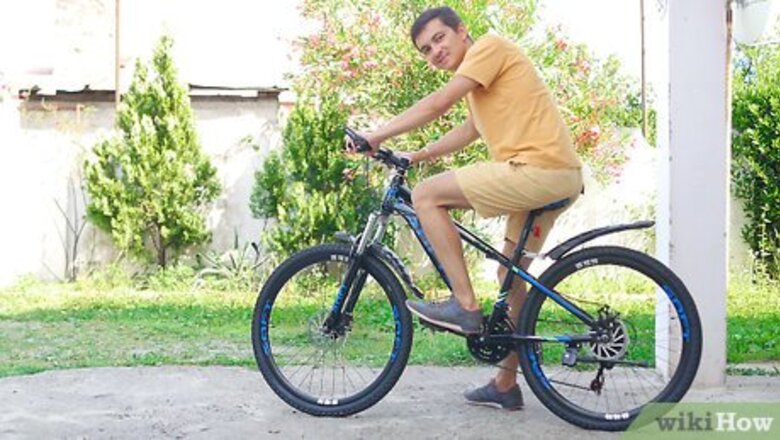
views
Adjusting Seat Height
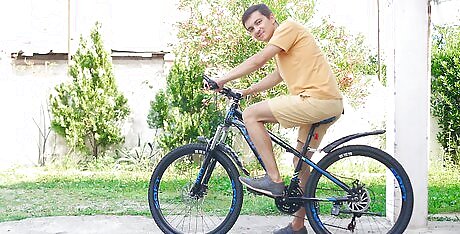
Know that a seat at the correct height leads to comfortable, even pedal strokes. You know your seat is at the right height if you can keep your hips stable on the bike instead of rocking them back and forth to reach the bottom of the pedal stroke. When your foot is at the lowest point while pedaling, you want your knee to be slightly bent, not locked out completely straight or curved. Your knee should be bent roughly 25 degrees. This feels similar to standing upright in an athletic position—just a slight bend is enough. If you do not have access to measuring tape, use this as your guideline for adjusting the seat height by hand: knee slightly bent, hips square while riding, and comfortable ability to pedal.
Measure your pubic bone height. Get some adhesive tape, a metal measuring tape, and 2 paint sticks or rulers. Trap the end of the measuring tape between the paint sticks and tape them together. Plant your bare feet flat on the floor, 10 inches (25 cm) apart. Insert the paint sticks between your legs perpendicular to your hips and pull them straight up until you hit your pubic bone. Hold the sticks firmly in place, with one hand in front of your crotch and the other behind your rear. Have a friend pull the measuring tape down to the floor and measure the distance from your pubic bone to the floor. For an accurate measurement, your friend should position the measuring tape midway between your feet. It may be helpful to mark off the 10 inches (25 cm) on the floor so that you can position your feet and the tape correctly. Measure at least 2-3 times to make sure you get an accurate reading. If you took the measurement in inches, convert it to centimeters. You can then calculate your saddle height by subtracting 10 to 10.5 centimeters from your pubic bone height. For example, if your PBH is 84 centimetres (33 in), your saddle height would be 73.5–74 centimetres (28.9–29.1 in). The saddle height measurement is from the bottom bracket (where the cranks attach to the frame of your bike) to the top of the saddle.
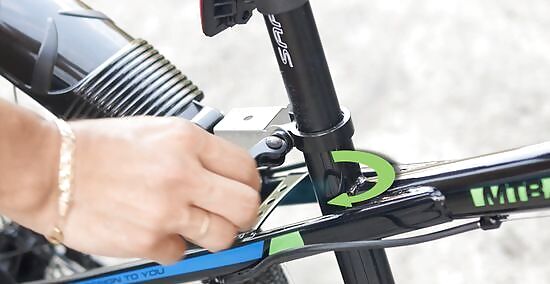
Learn how your seat post adjusts. Seat posts are loosened and adjusted at the junction where the seat post meets the bike frame. A quick-release lever at the base of the seat post can be pried opened and adjusted by hand. If there is a small bracket with a screw in it, you have a bolted seat post: use an Allen key or adjustable wrench to loosen the bolt just enough to move the seat post.
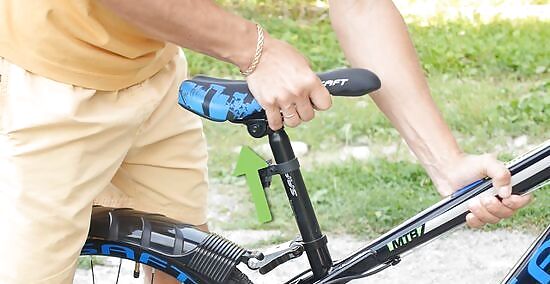
Adjust the seat height to your measured length. Gently slide the seat post up or down to reach your ideal measurement. It can help to nick the post at the right height, so you can find this adjustment again if the seat slips or someone borrows the bike.
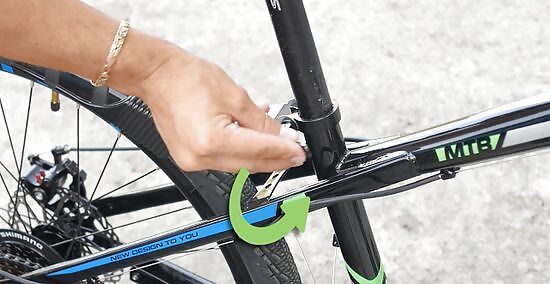
Tighten the seat firmly. Either press the quick-release lever back down to its locked position, or re-tighten the bolts with your Allen key or adjustable wrench until there is no movement. You do not need to get it so tight that you can't undo it later. Basic hand tightness will be enough for many bikes. If you're not sure how much to tighten the seat, check your owner's manual or the manufacturer's website for torque specifications. This is especially important if your bike has a carbon fiber seatpost or frame.
Check your measurement on a test ride. Head out into the driveway and go for a slow test ride. Make sure you can easily reach the pedals and get onto the bike, and your knees are not locked. Try standing while you pedal to make sure you can comfortably get out of the saddle. Make sure that the seat is facing straight ahead or your riding position will be awkward and uncomfortable. Place the ball of your foot on the pedal when you ride. There should now be a slight bend (25 degrees) in your knee when the pedal is at its lowest point. This is your optimal seat height. If you have clip pedals or cages, make sure you use them on your test ride—they will affect your ride. Everyone has a different body type—your pubic bone height measurement should be used as a starting point. You should then adjust the bike to fit you comfortably. Use a simple guideline when adjusting seat height. "I hadn't ridden a bike in years and almost forgot how to adjust the seat height properly. Following the clear 25-degree knee bend guideline in Step 1 made it easy for me to dial in the right height for a comfortable ride." - Dilip D. Correct seat issues to enable easy mounting. "As a 73-year-old getting back into biking after a long break, I appreciated how Step 1 set me up with the ideal height to easily mount the bike without struggling. Fine-tuning the height a bit during my test ride really made mounting smooth and painless." - Butch C. Feel confident tackling bike adjustments. "After watching confusing bike adjustment videos, having simple pictorial steps laid out made me feel I could actually do this myself. I got my seat adjusted perfectly in just 10 minutes!" - Arlene D. Utilize fit guidance when testing bikes. "With all the nuanced bike fitting advice here, I felt fully prepared when going to test ride models yesterday. I could effectively assess comfort and fit rather than just randomly trying bikes." - Beverly T. We want to hear from you! Advice from our readers makes our articles better. If you have a story you’d like to share, tell us here.
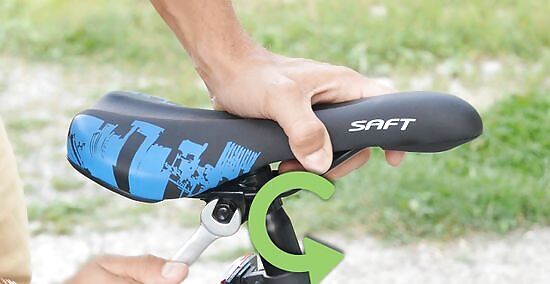
Troubleshoot any issues by moving the seat slightly up or down. If you have knee pain, the biggest cause is usually your seat height. Depending on where the pain is, you likely have different problems. However, if the pain does not go away with seat adjustments, you should see a doctor. If the pain is on the back of your knee, the seat is too high. If the pain is on the front of your knee, the seat is too low. Your hips should be sturdy, not rocking, while you pedal. If you slide your hips to each side with your pedal strokes, your seat is too high.
Adjusting Seat Placement
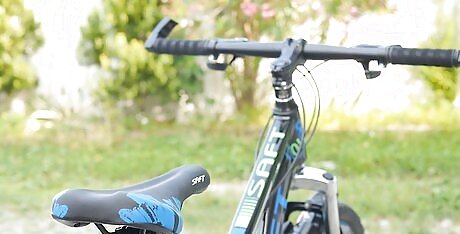
Know that the angle and forward position of a bike seat will affect your riding comfort. The height of your seat isn't the only thing that matters. Seats can be slid forward and backward and angled up or down to get rid of sore spots and make a more comfortable ride. To test for the perfect fore/aft position of the seat: While riding, stop your feet so that one pedal is at the 3:00 position (completely forward). Your foot should be flat. Imagine a straight line coming down from the front of your knee to the ground. This line should intersect through the middle of your pedal. In other words, your knee should be right over your pedal when in the 3:00 position.
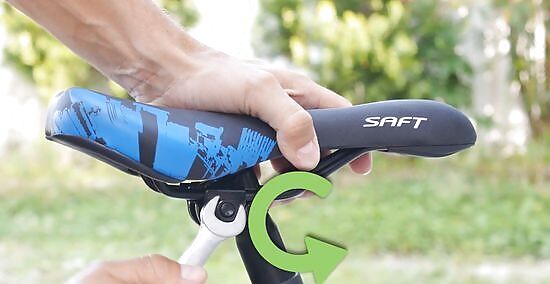
Loosen the bolt underneath the seat to change forward/backward seat position. On the back of the seat, pointing down at the back wheel, is a small bolt that controls the seat placement. It connects to a bracket that clamps onto small metal tubes that hold the seat in place. Loosen this bolt by turning it counter-clockwise to lower the pressure on the clamps that keep the seat in place.
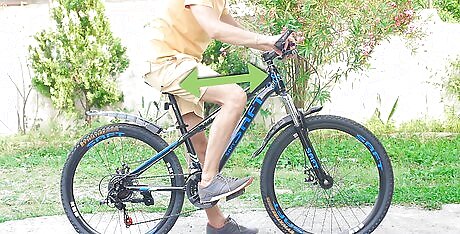
Make sure the seat is far enough forward for a comfortable ride. You should be able to comfortably reach your handlebars, and your knee should be over the pedal when your foot is at 3:00 in the pedal rotation. A good test is to try standing as you ride. If your seat is in the right position, you should be able to stand up easily without pulling or pushing on the handlebars. If you experience any of the following problems, slide the seat forward or back while the bolt is still loose: Trouble standing or reaching for the bars and finger numbness can mean the seat is too far back. Shoulder pain and trouble feeling comfortable going down hills can mean your seat is too far forward.
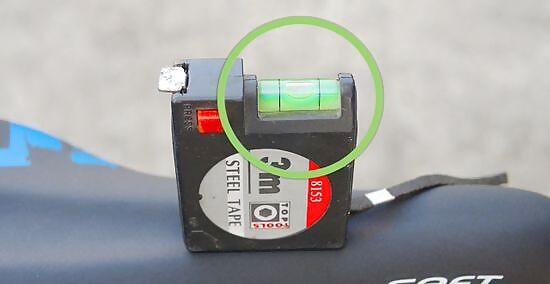
Make sure that your seat angle is level with the floor. Use a carpenter's level to make sure the seat is flat—this evenly distributes your weight for more comfortable riding. That said, if you experience discomfort in your crotch you can adjust the seat a little, though no more than 3 degrees in either direction. Women should typically tilt the seat slightly down for more comfort. Men should typically tilt the seat slightly up for more comfort.
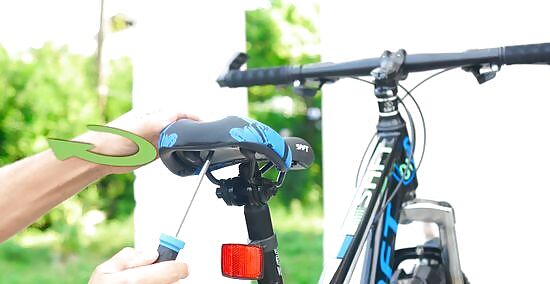
Loosen the bolts on the side of the seat to change the seat angle. This bolt, usually on the right of the seat, allows you to easily change the angle of the seat and then tighten it in place again. Some older seats have 2 small bolts underneath the seat, one in front of the seat post and one behind, that are needed to change the seat angle. You must tighten one side to push that side up while loosening the other, almost like a see-saw. Never make large adjustments to your seat angle. Check your seat height and forward position first, then adjust the angle slightly, if at all.
Visit a bike shop if you'd prefer a professional seat fitting. If you're having trouble getting your seat height and angle adjusted correctly, go to your local bike shop and ask if they have a fit studio. They can help you adjust your seat more precisely so that you get a safe and comfortable fit. Some fitting studios have sophisticated technology that can detect pressure points between your body and the saddle, allowing for extremely precise adjustments.


















Comments
0 comment